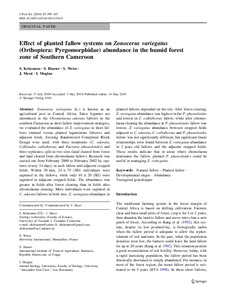| dc.contributor.author | Kekeunou, S. |
| dc.contributor.author | Hauser, S. |
| dc.contributor.author | Weise, S. |
| dc.contributor.author | Messi, J. |
| dc.contributor.author | Moglan, I. |
| dc.date.accessioned | 2019-12-04T11:11:14Z |
| dc.date.available | 2019-12-04T11:11:14Z |
| dc.date.issued | 2010 |
| dc.identifier.citation | Kekeunou, S., Hauser, S., Weise, S., Messi, J. & Moglan, I. (2010). Effect of planted fallow systems on Zonocerus variegatus (Orthoptera: Pyrgomorphidae) abundance in the humid forest zone of Southern Cameroon. Journal of Pest Science, 83(4), 399-407. |
| dc.identifier.issn | 1612-4758 |
| dc.identifier.uri | https://hdl.handle.net/20.500.12478/2383 |
| dc.description.abstract | Zonocerus variegatus (L.) is known as an agricultural pest in Central Africa. Since legumes are introduced in the Chromolaena odorata fallows in the southern Cameroon as short fallow improvement strategies, we evaluated the abundance of Z. variegatus in short fallows (natural versus planted leguminous fallows) and adjacent fields. Existing Randomized Completed Block Design were used, with three treatments (C. odorata, Calliandra callothyrsus and Pueraria phaseoloides) and three replicates, split in two sites (land cleared from forest and land cleared from chromolaena fallow). Research was carried out from February 2000 to February 2002 by captures (every 14 days) in each fallow and adjacent cropped fields. Within 30 min, 24 ± 75 (SD) individuals were captured in the fallows, while only 10 ± 20 (SD) were captured in adjacent cropped fields. The abundance was greater in fields after forest clearing than in fields after chromolaena clearing. More individuals were captured in C. odorata fallows in both sites. Z. variegatus abundance in planted fallows depended on the site. After forest clearing, Z. variegatus abundance was highest in the P. phaseoloides and lowest in C. callothyrsus fallow, while after chromolaena clearing the abundance in P. phaseoloides fallow was lowest. Z. variegatus abundance between cropped fields adjacent to C. odorata, C. callothyrsus and P. phaseoloides fallow was not significantly different, but significant linear relationships were found between Z. variegatus abundance in 2 years old fallows and the adjacent cropped fields. These results indicate that in areas where chomolaena dominates the fallow, planted P. phaseoloides could be useful in managing Z. variegatus |
| dc.format.extent | 399-407 |
| dc.language.iso | en |
| dc.subject | Natural Fallow |
| dc.subject | Planted Fallow |
| dc.subject | Developmental Stages |
| dc.subject | Abundance Variegated |
| dc.subject | Grasshopper |
| dc.title | Effect of planted fallow systems on Zonocerus variegatus (Orthoptera: Pyrgomorphidae) abundance in the humid forest zone of Southern Cameroon |
| dc.type | Journal Article |
| dc.description.version | Peer Review |
| cg.contributor.affiliation | Université d'Abomey Calavi |
| cg.contributor.affiliation | International Institute of Tropical Agriculture |
| cg.contributor.affiliation | Bioversity International |
| cg.contributor.affiliation | University Alexandru Ioan Cuza |
| cg.coverage.region | Africa |
| cg.coverage.region | Central Africa |
| cg.coverage.country | Cameroon |
| cg.isijournal | ISI Journal |
| cg.authorship.types | CGIAR and developing country institute |
| cg.iitasubject | Farming Systems |
| cg.journal | Journal of Pest Science |
| cg.howpublished | Formally Published |
| cg.accessibilitystatus | Limited Access |
| local.dspaceid | 92292 |
| cg.targetaudience | Scientists |
| cg.identifier.doi | https://dx.doi.org/10.1007/s10340-010-0310-9 |

